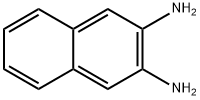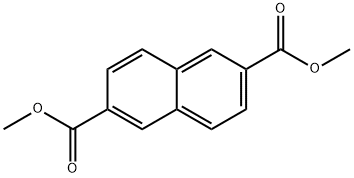2,3-Naphthalenedicarboxylic acid
- CAS NO.:2169-87-1
- Empirical Formula: C12H8O4
- Molecular Weight: 216.19
- MDL number: MFCD00004104
- EINECS: 218-517-7
- SAFETY DATA SHEET (SDS)
- Update Date: 2024-12-18 13:37:16

What is 2,3-Naphthalenedicarboxylic acid?
Description
2,3-Naphthalenedicarboxylic acid, also known as 2,3-naphthalic acid, belongs to the class of organic compounds known as naphthalenecarboxylic acids. Naphthalenecarboxylic acids are compounds containing a naphthalene moiety that bears a carboxylic acid group in one or more positions. Naphthalene is a bicyclic compound that is made up of two fused benzene rings. 2,3-Naphthalenedicarboxylic acid is an important chemical intermediate with important applications in fine chemicals. It can be used as a raw material or intermediate for synthesizing liquid crystal display materials, medicines, pesticides, spices, and inks.
Chemical properties
OFF-WHITE TO BEIGE POWDER
The Uses of 2,3-Naphthalenedicarboxylic acid
2,3-Naphthalenedicarboxylic Acid (cas# 2169-87-1) is a compound useful in organic synthesis.
Synthesis
Using o-phthalaldehyde as raw material, the 2,3-Naphthalenedicarboxylic acid is finally produced through acetalization reaction, reduction reaction, hydrolysis reaction, cycloaddition reaction, dehydration reaction, and hydrolysis reaction.
Synthesis Reference(s)
Journal of the American Chemical Society, 81, p. 6458, 1959 DOI: 10.1021/ja01533a032
Organic Syntheses, Coll. Vol. 5, p. 810, 1973
Properties of 2,3-Naphthalenedicarboxylic acid
| Melting point: | 238-240 °C (dec.) (lit.) |
| Boiling point: | 316.6°C (rough estimate) |
| Density | 1.3023 (rough estimate) |
| refractive index | 1.7080 (estimate) |
| storage temp. | Sealed in dry,Room Temperature |
| form | Solid |
| pka | 2.95±0.30(Predicted) |
| color | Off-white |
| BRN | 1967507 |
| InChI | InChI=1S/C12H8O4/c13-11(14)9-5-7-3-1-2-4-8(7)6-10(9)12(15)16/h1-6H,(H,13,14)(H,15,16) |
| CAS DataBase Reference | 2169-87-1(CAS DataBase Reference) |
| EPA Substance Registry System | 2,3-Naphthalenedicarboxylic acid (2169-87-1) |
Safety information for 2,3-Naphthalenedicarboxylic acid
| Signal word | Warning |
| Pictogram(s) |
 Exclamation Mark Irritant GHS07 |
| GHS Hazard Statements |
H315:Skin corrosion/irritation H319:Serious eye damage/eye irritation H335:Specific target organ toxicity, single exposure;Respiratory tract irritation |
| Precautionary Statement Codes |
P302+P352:IF ON SKIN: wash with plenty of soap and water. P305+P351+P338:IF IN EYES: Rinse cautiously with water for several minutes. Remove contact lenses, if present and easy to do. Continuerinsing. |
Computed Descriptors for 2,3-Naphthalenedicarboxylic acid
| InChIKey | KHARCSTZAGNHOT-UHFFFAOYSA-N |
| SMILES | C1=C2C(C=CC=C2)=CC(C(O)=O)=C1C(O)=O |
New Products
(S)-3-Aminobutanenitrile hydrochloride 4-Methylphenylacetic acid N-Boc-D-alaninol N-BOC-D/L-ALANINOL Tert-butyl bis(2-chloroethyl)carbamate 3-Morpholino-1-(4-nitrophenyl)-5,6-dihydropyridin- 2(1H)-one Furan-2,5-Dicarboxylic Acid Tropic acid 1-Bromo-3,5-Di-Tert-Butylbenzene S-2-CHLORO PROPIONIC ACID ETHYL ISOCYANOACETATE 2-Bromo-1,3-Bis(Dimethylamino)Trimethinium Hexafluorophosphate 4-IODO BENZOIC ACID 3-NITRO-2-METHYL ANILINE 1-(2,4-DICHLOROPHENYL) ETHANAMINE (2-Hydroxyphenyl)acetonitrile 4-Bromopyrazole 2-(Cyanocyclohexyl)acetic acid 4-methoxy-3,5-dinitropyridine 1-(4-(aminomethyl)benzyl)urea hydrochloride 2-aminopropyl benzoate hydrochloride diethyl 2-(2-((tertbutoxycarbonyl)amino) ethyl)malonate tert-butyl 4- (ureidomethyl)benzylcarbamate Ethyl-2-chloro((4-methoxyphenyl)hydrazono)acetateRelated products of tetrahydrofuran








You may like
-
 2,3-Naphthalenedicarboxylic Acid CAS 2169-87-1View Details
2,3-Naphthalenedicarboxylic Acid CAS 2169-87-1View Details
2169-87-1 -
 2,3-Naphthalenedicarboxylic acid CAS 2169-87-1View Details
2,3-Naphthalenedicarboxylic acid CAS 2169-87-1View Details
2169-87-1 -
 1975-50-4 98%View Details
1975-50-4 98%View Details
1975-50-4 -
 2-HYDROXY BENZYL ALCOHOL 98%View Details
2-HYDROXY BENZYL ALCOHOL 98%View Details
90-01-7 -
 2-Chloro-1,3-Bis(Dimethylamino)Trimethinium Hexafluorophosphate 221615-75-4 98%View Details
2-Chloro-1,3-Bis(Dimethylamino)Trimethinium Hexafluorophosphate 221615-75-4 98%View Details
221615-75-4 -
 61397-56-6 CIS BROMO BENZOATE 98%View Details
61397-56-6 CIS BROMO BENZOATE 98%View Details
61397-56-6 -
 14714-50-2 (2-Hydroxyphenyl)acetonitrile 98+View Details
14714-50-2 (2-Hydroxyphenyl)acetonitrile 98+View Details
14714-50-2 -
 118753-70-1 98+View Details
118753-70-1 98+View Details
118753-70-1